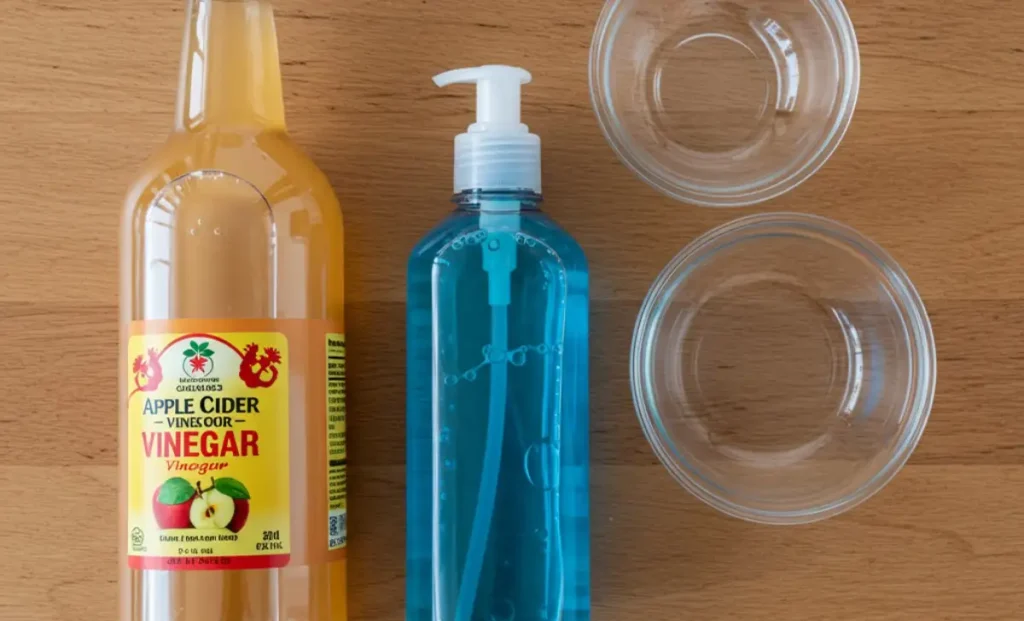Are those tiny, annoying black flies buzzing around your kitchen, your plants, or your face? You’re likely dealing with gnats, and they can quickly go from a minor nuisance to a full-blown infestation. It can feel like they appear out of nowhere and never leave.
But don’t worry, there’s a simple and incredibly effective solution. This guide will show you a proven, step-by-step method to create a DIY gnat trap that works like magic. After reading, you’ll know exactly how to get rid of gnats and keep them from coming back.
What You’ll Need: Tools & Materials
You probably already have everything you need in your kitchen.

- A small bowl, jar, or shallow dish
- Apple Cider Vinegar
- Liquid dish soap
- Plastic wrap (optional)
- A toothpick or fork (optional)
How to Get Rid of Gnats with a DIY Vinegar Trap
This simple vinegar trap is the most popular and effective way to quickly reduce the gnat population in your home.
Step 1: Choose Your Trap Location
Before you make the trap, find out where the gnats are hanging out. Common spots include near kitchen sinks, garbage cans, indoor plants, or fruit bowls. You’ll want to place your trap right in the middle of their favorite area.
Step 2: Prepare the Trap Container
Take your small bowl or jar and place it on a flat surface. Make sure it’s clean and has no other food residue inside. A shallow container works best because it provides a larger surface area for the vinegar.
Step 3: Add the Apple Cider Vinegar
Pour about an inch of apple cider vinegar into the container. Gnats are highly attracted to the sweet, fermented smell of this vinegar. It lures them right to your trap. If you don’t have apple cider vinegar, you can also use red wine or even a piece of overripe fruit as bait.
Step 4: Add a Drop of Dish Soap
Squeeze just one or two drops of liquid dish soap into the vinegar. Do not stir it vigorously; a gentle swirl is enough. The soap is the secret ingredient. It breaks the surface tension of the vinegar, so when the gnats land for a drink, they can’t escape and will sink.
Step 5: Place Your Trap
Carefully place your new gnat trap in the location you identified in Step 1. Now, just leave it alone and let it do its work. You should start seeing results within a few hours as the gnats are drawn to the scent and become trapped. Refresh the trap with new vinegar and soap every couple of days.
How to Prevent Gnats from Coming Back
Catching gnats is one thing, but stopping them from returning is the real goal. Gnats thrive in moist environments with decaying organic matter. Here’s how to make your home less inviting for them:
- Clean Your Drains: Fungus gnats often breed in the gunk that builds up in sink drains. Pour a mixture of white vinegar and baking soda, or a diluted bleach solution, down your drains weekly to clear them out.
- Don’t Overwater Plants: Soil that is too damp is a perfect breeding ground for fungus gnats. Allow the top inch or two of soil to dry out completely between waterings.
- Manage Your Trash: Take out the garbage regularly, especially if it contains food scraps. Make sure your trash cans have tight-fitting lids.
- Store Fruit Properly: Don’t leave ripe or rotting fruit out on the counter. Store it in the refrigerator or in sealed containers.
Pro Tips for Success
Be Patient: While the trap works quickly, it might take a few days to catch a large population. Set multiple traps if you have gnats in different areas.
Identify the Source: The most common mistake is only setting traps without removing what’s attracting the gnats in the first place. Find and eliminate their food source and breeding ground (like a forgotten potato in the pantry or a soggy plant) for long-term success.
Know Your Pest: This trap is fantastic for fruit flies and fungus gnats. If you have drain flies, focusing on cleaning your drains is even more critical. According to the University of Kentucky’s Entomology department, proper sanitation is the key to eliminating most small fly problems.
Frequently Asked Questions (FAQ)
What is the fastest way to get rid of gnats?
The fastest way is the apple cider vinegar and dish soap trap described in this guide. It starts working within hours to attract and trap adult gnats, quickly reducing their numbers.
What causes a gnat infestation in the house?
Gnat infestations are usually caused by two things: excess moisture and a source of decaying organic food. This can include overwatered houseplants, rotting fruit on the counter, food scraps in the garbage, or built-up gunk in your sink drains.
Do gnats go away on their own?
Unfortunately, no. Gnats reproduce very quickly. A few gnats can turn into a major infestation in just a week or two if their breeding ground isn’t eliminated. You need to actively remove their food source and use traps to get rid of them.
Conclusion
Getting rid of gnats is much easier than you think. By creating a simple DIY trap and removing their food sources, you can quickly reclaim your home from these tiny pests and keep it that way.
For more helpful guides and solutions, visit howtoresults.com to explore our wide range of how-to articles.
Leave a Reply